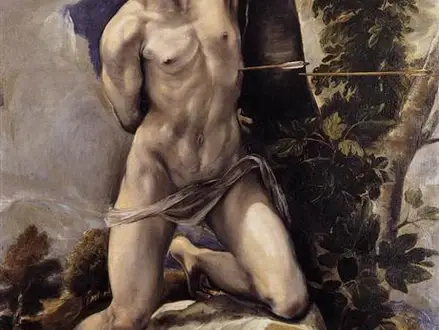Title of Artwork: “St. Sebastian”

Artwork by El Greco
Year Created 1577
Summary of St. Sebastian
An autographed work by El Greco, Doménikos Theotokópoulos, or El Greco, is the Martyrdom of St. Sebastian. It depicts the martyred saint in an unusual kneeling position, which some scholars believe to be a compositional quotation from works by other great masters that the artist admired. The painting is currently on display in Palencia Cathedral.
All About St. Sebastian
Because of this, it is impossible to know with any certainty where exactly this work came from; the only option left is to speculate. El Greco’s first decade in Spain, roughly 1576-79, has been dated based on stylistic clues and the available evidence.
It has long been speculated that El Greco’s first major commission in Spain, the decoration of three altarpieces in the convent Santo Domingo el Antiguo (Monastery of St. Dominic of Silos (the Old)), was obtained for him by Diego de Castilla, dean of the cathedral and father of El Greco’s friend Luis, who was El Greco’s best friend.
Johnathan Brown’s discussion of the Palencia Sebastian, for example, simply notes that “possibly” it was painted for Diego de Castilla based on stylistic similarity and the artist’s historical timeline. However, this assignment of patronage isn’t universally agreed upon.
According to Jesus San Martin Payo, based on his study of a sixteenth century manuscript on the history of the diocese of Palencia, Don Juan Alonso de Cordoba, “right arm of the bishop, don Juan Ramirez Zapata de Cardenas, patron of the chapel of San Jeronimo, and in whose sacristy” (brazo del obispo don Juan Ramirez Zapata de Cardenas) owned the painting.
This alternative theory suggests that the Martyrdom of Saint Sebastian predates El Espolio, or The Disrobing of Christ, which is generally considered the artist’s first known Spanish work, as he served as Bishop of the diocese from 1570 until his death in 1577.
Saint Sebastian is depicted in the painting as a victim of Diocletian’s persecution of Christianity in the 4th century AD. A popular myth has it that Sebastian was tied to a tree, shot with arrows, and miraculously rescued and healed, before being killed by a club shortly after.
Both the Roman Catholic and Greek Orthodox churches revere Saint Sebastian. During the 15th and 16th centuries, when the painting was first put on display, Saint Sebastian was frequently invoked as a divine intercessor for plague victims because he had been pierced with arrows, a symbol associated with divine punishment since antiquity.
El Greco and his contemporaries painted numerous images of St. Sebastian, perhaps because of his popularity during the second plague pandemic or because his martyrdom offered Counter-Reformation era artists one of the few opportunities to depict the nude in religious art.
Information Citations
En.wikipedia.org, https://en.wikipedia.org/.























